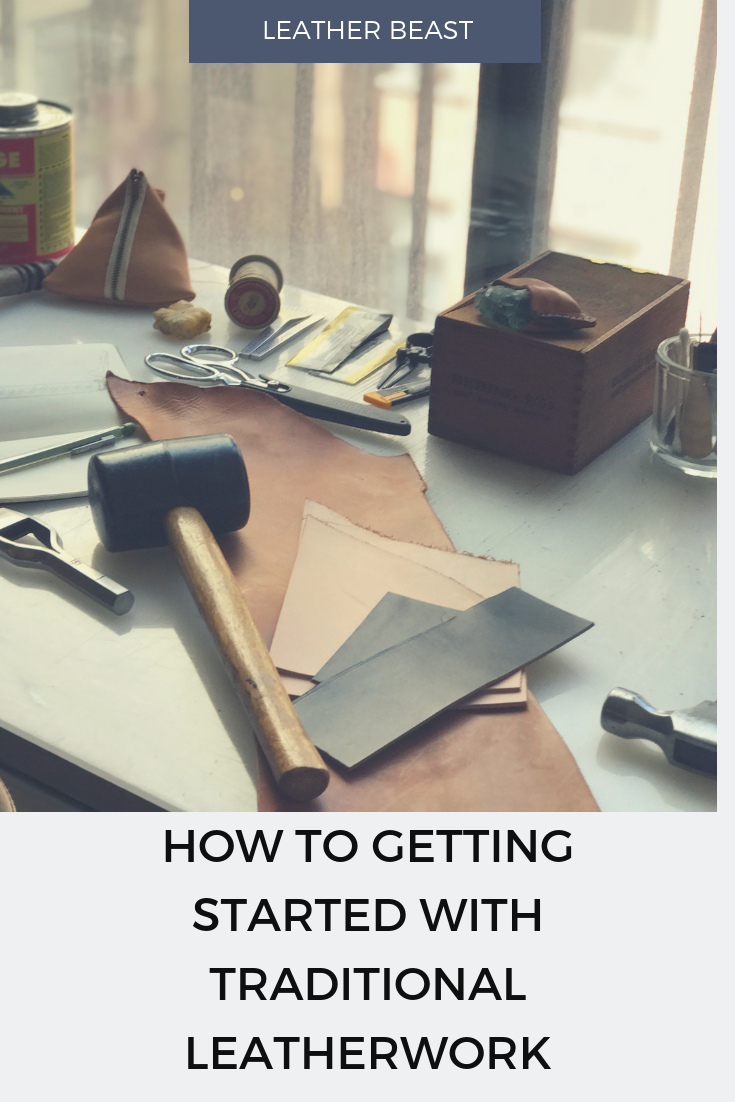Three Tips For Getting Started With Traditional Leatherwork
Back in 2012 I worked at a job where they had a creative workshop program. All expenses paid. I worked for an awesome woman who really believed in creating an awesome work environment and she cared about giving back to her employees.
I began my search for a leather workshop but I was coming up empty. There really aren’t too many hands on leather workshops out there. And there are only another handful in Europe.
But finally I found this woman in California who had a leather school. I was so excited! As I dug deeper into my research I learned that she not only was a leather master but she had some serious street cred. She apprenticed out of highschool with Hermes, in France and then continued to work there as a leather artisan for many years.
So this long story short, I got my all expenses paid workshop approved and I attended this leather workshop and learned traditional leatherworking basics.
This is how I got into traditional leatherwork.
Now I understand this is not how most people get into leatherwork. Most people struggle just to figure out what tools and materials they need.
So I was really lucky in that sense.
So you might be wondering, how can you get started without having to spend thousands on an in person workshop.
Btw, I would highly recommend her school, but I know the cost is somewhat prohibitive for people.
If you’re an absolute beginner, never picked up a leatherworking tool in your life and want to get started with traditional leatherwork, then you might want to check out my road map to getting started with traditional leatherwork.
My roadmap ensures you stay on track bypass frustrating situations like:
Choosing the wrong tools or unnecessary tools and wasting money.
Wasting time trying to figure this stuff out on your own.
Learning incorrect techniques and having to correct your mistakes later.
If you want to avoid those mistakes, then follow my roadmap below which lists the 6 steps to getting started with traditional leatherwork.
These steps involve getting the right tools and materials, learning the correct techniques and implementing the techniques on beginner projects. Once you have the right tools and materials you’re on your way to learning the techniques and honing your leatherworking skills.
Top tips for how to get started with Traditional Leatherwork.
#1 | Determine what kind of leatherwork is it that you’re interested in doing.
Not all leatherwork is the same. You’ve got rustic methods, where the stitching doesn’t have to be perfect, you’ve got american west style where the thread tends to be thicker, stitches aren’t necessarily slanted and then you have the European refined method. This is the method that I learned from my teacher and what I teach in my Mastering Traditional Leatherworking Basics course.
I did make some tweaks to what I learned however. For example, I teach leather craft using stitching chisels in stead of pricking irons because it’s a little easier for the beginner to get right off the bat.
# 2 | Gather leather and materials that you can practice on.
I highly recommend getting some good scrap practice leather instead of purchasing an entire side of cowhide right off the bat if you can. If you opt to go for a side from the get go, you’re spending a lot of money upfront and you run the risk of purchasing the incorrect kind of leather for your project or you might get a piece that you just don't like working with.
Expensive leather can also be intimidating to the beginner for fear of messing up and wasting it. Get to know different types and weights of leather first before purchasing a large expensive hide. You don’t want a fancy piece of leather to hinder or intimidate you into not practicing your saddle-stitching or taking action.
You can head to ebay or buy smaller scraps from a lot of leather outlets.
#3 Take time to learn and master the basics techniques
By taking the time to learn the correct tools and techniques upfront you will save yourself time, frustration and a lot of headache.
For example there are a few different steps involved in preparing your leather piece. First you must create your stitch guide so that your stitches line up evenly and in straight formation. If you don’t use a stitching guide your stitches tend to look sloppy and crooked.
Next comes the stitching marks or stitching holes. This is a very important part of preparing your work. When you create these marks or holes you are providing the foundation for your saddle-stitching. Make sure your your stitching chisels pierce the leather all the way through so that when it comes time to stitch you have clear access and don’t have to re-punch the holes.
After that, it really comes down to practice, practice, practice. Avoid moving on to complicated projects before you’ve really mastered the basics. It will save you a lot of time and money in the long run. Because you’ll mess up less and create more beautiful work each time.
If you’re interested in getting started with traditional leatherwork, download my guide, HOw to get started with leatherwork. It’s a roadmap that give you the steps for how to get started and what kinds of mistakes to avoid.
Just because you might not be able to take an in person workshop with a master leatherworker doesn’t mean you can’t learn to create beautiful traditional leatherwork. Your road to traditional leatherwork does not have to be a tough road if you follow these steps and make sure you master the basics prior to moving on to more complex projects.


